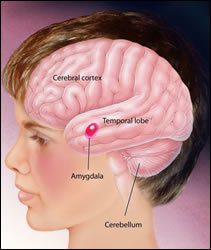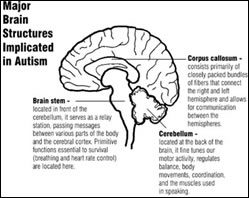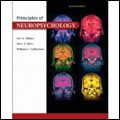Autism and the Brain
By: Candace Hutchins
Pervasive developmental disorders are the disorders on the autism spectrum: autism, Asperger’s syndrome, Rett’s syndrome, and childhood disintegrative disorder.
Children with autism have impairment in language skills and distinct behavioral symptoms such as repetitive or stereotypical behavior. They also have poor social skills and are unable to connect and interact with other people (Zillmer, 2008).
 Neuropathological studies of children with autism show that they have increased levels of serotonin, losses in the frontal lobes ability to function causing differences in facial recognition and processing. They also have a greater head circumference and a larger brain size (but smaller than normal at birth). Additionally they have found that children with autism have abnormal brain connectivity, a disruption in white-gray matter ratio and limbic system abnormalities in activity level, size and density (Zillmer, 2008). Finally, unusual motor movements in children with autism such as walking on their toes and hand slapping may be a result of structural and functional abnormalities of the cerebellum.
Neuropathological studies of children with autism show that they have increased levels of serotonin, losses in the frontal lobes ability to function causing differences in facial recognition and processing. They also have a greater head circumference and a larger brain size (but smaller than normal at birth). Additionally they have found that children with autism have abnormal brain connectivity, a disruption in white-gray matter ratio and limbic system abnormalities in activity level, size and density (Zillmer, 2008). Finally, unusual motor movements in children with autism such as walking on their toes and hand slapping may be a result of structural and functional abnormalities of the cerebellum.
Autism is diagnosed in children according to results from the Autism Diagnostic Interview-R and Autism Diagnostic Observation Schedule. Many of the cognitive symptom profiles of children with autism are similar to the profiles of children with nonverbal learning disabilities. Cognitive symptoms often include preservation on executive functioning tasks, poor executive planning, working memory, mental flexibility and response inhibition. They also have poor facial recognition, social orientation, attention and no “theory of mind”.

Disrupted white-gray matter ratio and disrupted connectivity may cause fragmented processing of incoming information from different sensory systems. There are also studies on the temporal lobe-limbic system that show a volume reduction and abnormalities in neuronal size and density. Other research has suggested that damage to the limbic system specifically the amygdala, may produce autistic behaviors.
Treatment for autism is Behavior Modification (ABA=applied behavioral analysis) and medication such as SSRIs or antipsychotics to treat certain symptoms and behaviors that are self-injurious, aggressive, or stereotypic.
Similar brain anomalies and symptoms are observed in other disorders on the Autism spectrum. Asperger’s Syndrome is a mild for of autism and the child does not have any symptoms of language impairment. Rett’s Disorder is a disorder that only occurs in females and is a degenerative loss of motor and language skills onset sometime between 5 and 48 months. Finally, Childhood Disintegrative Disorder is a deterioration of skills after age 2 that occurs primarily in males and attacks two domains of language, social, elimination, play or motor skills.
 This information is based on an advanced college neuropsychology course and references the following textbook:
This information is based on an advanced college neuropsychology course and references the following textbook:
Zillmer, Eric A., Mary V. Spiers, William Culbertson (2008). Principles of
Neuropsychology. Wadsworth Publishing.


